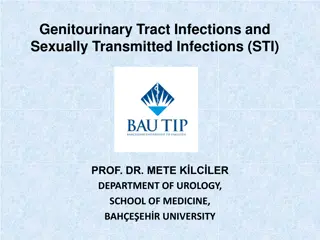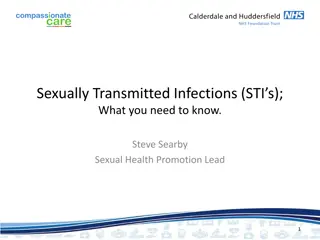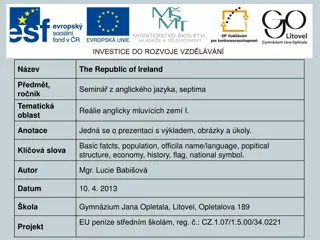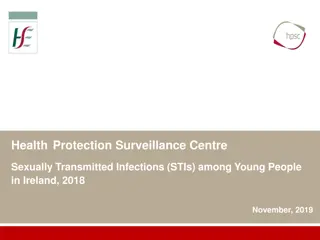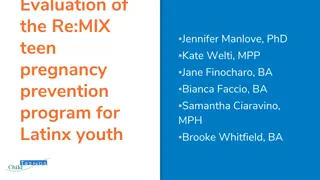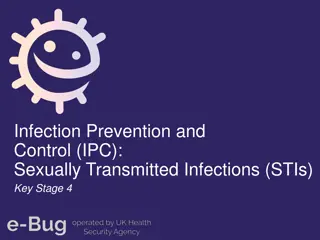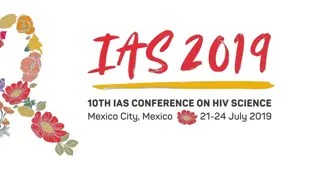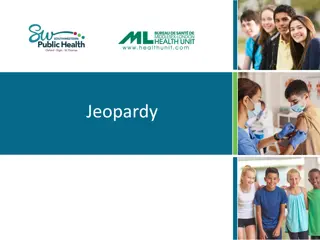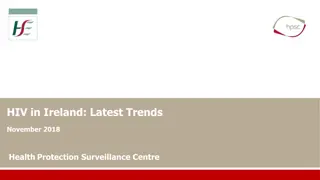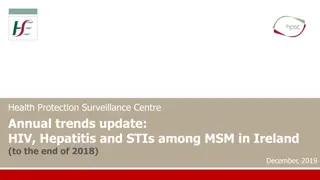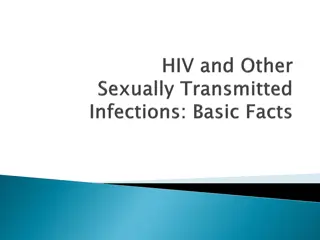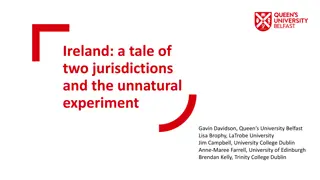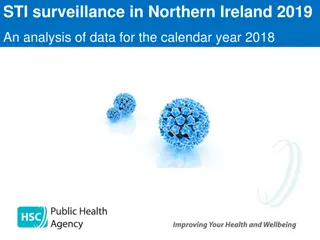STIs in Ireland: Trends and Key Findings up to 2018
The Health Protection Surveillance Centre in Ireland reported an increasing trend in sexually transmitted infections (STIs) in 2018. The notification rate per 100,000 population showed rises in various STIs, with particular prevalence among young people aged 15-24 years. Chlamydia, herpes simplex, and gonorrhea were commonly reported in this age group. Men who have sex with men (MSM) also saw an increase in early infectious syphilis and gonorrhea cases. It is crucial to address these trends through preventive measures such as safer sex practices and regular STI testing, emphasizing the importance of condom use for vaginal, oral, and anal sex.
Download Presentation

Please find below an Image/Link to download the presentation.
The content on the website is provided AS IS for your information and personal use only. It may not be sold, licensed, or shared on other websites without obtaining consent from the author. Download presentation by click this link. If you encounter any issues during the download, it is possible that the publisher has removed the file from their server.
E N D
Presentation Transcript
Health Protection Surveillance Centre Sexually Transmitted Infections (STIs) in Ireland: Trends to the end of 2018 September 2019
Acknowledgements The Health Protection Surveillance Centre (HPSC) would like to thank all those who provided the data for this report, particularly the STI clinics, GPs, laboratories and personnel within the Departments of Public Health. STI data were extracted from CIDR between July and September, 2019, and may differ from those previously published due to ongoing updating of notification data in CIDR. These slides may be copied and reproduced, provided HPSC is acknowledged. Suggested citation: HSE-Health Protection Surveillance Centre. STI slideset 2018. Dublin: HPSC; 2019. 2
STIs in Ireland, 2018 These slides present data on STIs notified to HPSC during 2018 and trends to the end of 2018. https://www.hpsc.ie/a- z/sexuallytransmittedinfections/ https://www.hpsc.ie/a- z/sexuallytransmittedinfections/ publications/stireports/ More detailed reports on the epidemiology of STIs for 2018 are available on the HPSC website. HIV, hepatitis B and sexually transmitted enteric infections (STEI), such as shigellosis, are notified via CIDR and are reported separately. https://www.hpsc.ie/abouthpsc /annualreports/ 3
Summary of STIs in Ireland, 2018 Increasing trend in STIs continues in 2018 Notification rate / 100,000 population Highest age-specific rate Percentage change in rate from 2017 STI* Number Anogenital warts 1,031 21.7 25-29 years *** Chlamydia 7,932 166.6 20-24 years +7% Gonorrhoea 2,405 50.5 25-29 years +7% Herpes simplex (genital) 1,591 33.4 20-24 years +2% Lymphogranuloma venereum (LGV) 28 0.6 30-34 years +50% Non-specific urethritis (NSU) 518 10.9 ** *** Early infectious syphilis (EIS) 484 10.2 25-29 years +22% Trichomoniasis 64 1.3 25-29 years -7% Total 14,053 * There were no notifications of chancroid or granuloma inguinale in 2018 ** Data provided as total numbers only, breakdown by age not available *** Interpretation of AGW and NSU trends is difficult due to under-reporting in 2018 4
Key population groups Young people Notifications of chlamydia, herpes simplex and gonorrhoea in 15-24 year olds remained high in 2018; further information on STIs in young people is available at http://www.hpsc.ie/a- z/hivstis/sexuallytransmittedinfections/publications/stireports/ In 2018, 15-24 year olds accounted for: 49% of chlamydia cases 39% of herpes simplex cases 32% of gonorrhoea cases MSM (men who have sex with men) Notifications of early infectious syphilis and gonorrhoea in MSM increased in 2018; further information is available in annual epidemiological reports at http://www.hpsc.ie/abouthpsc/annualreports/ In 2018, MSM accounted for: 100% of LGV cases 86% of early infectious syphilis cases 65% of gonorrhoea cases (where mode of transmission was known) 5
Preventing STIs Safer sex and STI testing Use condoms for vaginal, oral and anal sex Reduce the number of partners and overlapping partners Get tested for STIs if: You have symptoms of an STI; Change your sexual partner; Have multiple or overlapping partners; Your partner has an STI. Further information on STIs and free sexual health services is available at https://www.sexualwellbeing.ie/ www.man2man.ie (resource for gay and bisexual men and other men who have sex with men in Ireland) 6
Anogenital warts in Ireland, 2018 Summary 1,031 cases of ano-genital warts notified in 2018, down from 1,281 cases in 2017 Notification rate was 21.7 per 100,000 population 57% of cases were male The highest age-specific rate was among 25-29 year olds, for both males and females, at 119.8/100,000 and 69.0/100,000, respectively Trends in the number and rate of AGW notifications should be interpreted with caution due to underreporting of cases in one HSE area for the second half of 2018, and due to missing data from some STI services in two HSE areas since 2013. 7
Anogenital warts in Ireland Figure 1. Trend in notification rate of anogenital warts by sex, 1995-2018 8
Chlamydia in Ireland, 2018 Summary 7,932 cases of chlamydia notified in 2018 (166.6 per 100,000 population) 7% increase on 2017 Increase was higher in males (+11%) than females (+4%) Females: increase highest in younger age groups (15-24 years) Males: increase highest in older age groups ( 25 years) Rate in males exceeded rate in females for the first time 49% of cases were young people aged 15-24 years 9
Chlamydia in Ireland Figure 2. Trend in notification rate of chlamydia by sex, 1995-2018 10
LGV in Ireland, 2018 Summary 28 cases of Lymphogranuloma venereum (LGV) notified in 2018, up from 20 cases in 2017 Notification rate was 0.6 per 100,000 population Median age: 36 years (range: 22-58 years) All cases were men who have sex with men 29% did not have symptoms of LGV infection 64% were HIV positive 11
Gonorrhoea in Ireland, 2018 Summary 2,405 cases of gonorrhoea notified in 2018 Notification rate increased by 7% to 50.5/100,000 from rate in 2017 Rate increased by 86% since 2015 84% males, 16% females Median age: 28 years (range: 16-72 years) Highest rate among males: 25-29 year age group (362.2/100,000); Highest rate among females: 20-24 year age group (120.5/100,000) Almost a third (32%) of cases were young people aged 15-24 years 65% of cases were among MSM and 35% among heterosexuals, where mode of transmission was known Rate among MSM has doubled since 2015 12
Gonorrhoea in Ireland Figure 3. Trend in notification rate of gonorrhoea by sex, 1995-2018 Introduction of case-based reporting 90 80 Notification rate per 100,000 population 70 60 50 40 30 20 10 0 1995 1996 1997 1998 1999 2000 2001 2002 2003 2004 2005 2006 2007 2008 2009 2010 2011 2012 2013 2014 2015 2016 2017 2018 Year Males Females Total 13
Herpes simplex (genital) in Ireland, 2018 Summary 1,591 cases of herpes simplex (genital) notified in 2018 Notification rate was 33.4 per 100,000 population in 2018; a 2% increase since 2017 (32.6/100,000) 72% of cases were among females The highest age-specific rate was among females aged 20-24 years (266.8/100,000) Median age: 27 years (range:14-84 years) 63% of cases were laboratory confirmed as herpes simplex virus type 1 and 36% as herpes simplex virus type 2; virus type was unknown for 1% of cases 14
Herpes simplex (genital) in Ireland Figure 4. Trend in notification rate of herpes simplex (genital) by sex, 1995-2018 60 50 Notification rate per 100,000 population 40 30 20 10 0 1995 1996 1997 1998 1999 2000 2001 2002 2003 2004 2005 2006 2007 2008 2009 2010 2011 2012 2013 2014 2015 2016 2017 2018 Males Females Total 15
Early infectious syphilis in Ireland, 2018 Summary 484 confirmed cases of early infectious syphilis (EIS) were notified in 2018 Notification rate increased to 10.2 per 100,000 population; up 22% from 2017 (8.4/100,000) 96% of cases were among males Median age: 34 years (range:16-76 years) The highest rate in males was in 30-34 year olds (57.2 per 100,000 population) and in females was in 20-24 year olds (6.6 per 100,000 population) The majority (78%) of cases were reported by HSE East Where mode of transmission was recorded, 86% of cases were in MSM Where HIV status was recorded, 40% of EIS cases were co-infected with HIV 25% of cases were consistent with syphilis reinfection 16
Early infectious syphilis in Ireland Figure 5. Trend in notification rate of early infectious syphilis by sex, 2000-2018 25 Case definition updated Case definition and procedure for notification updated Notification rate per 100,000 population 20 15 10 5 0 2000 2001 2002 2003 2004 2005 2006 2007 2008 2009 2010 2011 2012 2013 2014 2015 2016 2017 2018 Year Total Males Females 17
Trichomoniasis in Ireland, 2018 Summary 64 cases of trichomoniasis notified in 2018 The notification rate was 1.3 per 100,000 population, and has remained fairly steady since the early 2000s Sixty three cases (98%) were female, one male case was reported (2%) Median age: 34 years (range: 20-62 years) Numbers and rates should be interpreted with caution as some laboratories use new molecular testing methods that are not currently included in the laboratory criteria for notification, therefore cases may be underreported. 18
Trichomoniasis in Ireland Figure 6. Trend in notification rate of trichomoniasis, by sex 1995-2018 19
Other notifiable STIs in Ireland, 2018 Summary: chancroid, granuloma inguinale and non-specific urethritis There were 518 cases of non-specific urethritis (NSU) notified in 2018, a notification rate of 10.9 per 100,000 population. Interpretation of NSU trends is difficult due to increased underreporting of cases in the second half of 2018, and given the absence of information on the causes of NSU. There were no notifications of chancroid or granuloma inguinale reported in Ireland in 2018 20
Further Information More detailed tables on these provisional data are available on the HPSC website https://www.hpsc.ie/a- z/sexuallytransmittedinfections/public ations/stireports/ More detailed epidemiological reports are also available on the HPSC website http://www.hpsc.ie/abouthpsc/annual reports/ https://www.hpsc.ie/a- z/sexuallytransmittedinfections/public ations/stireports/stiweeklyreports/ You can stay up-to-date with current STI data with the Weekly HIV & STI report 21







